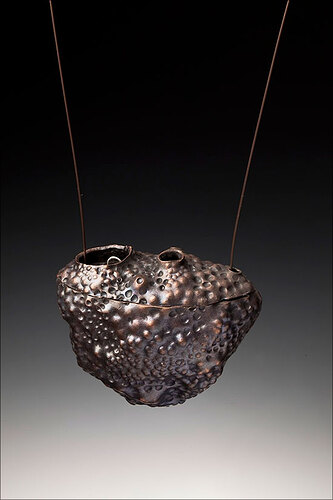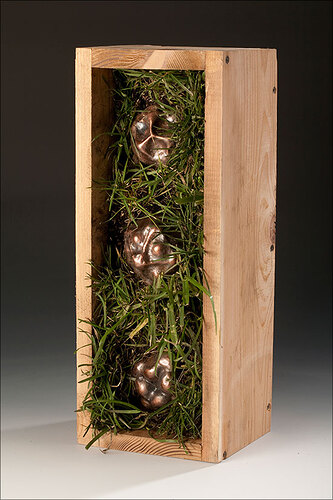Materials: Copper, Silver, Steel chain
Dimensions: 2" x 2" x 1"
This pendant opens by sliding the top half up on the chain. The top is held closed by gravity. When open, a small silver sculpture is in the base.
Photo credit: Tom Davis Photography
Samantha L McPherson
McPherson Metals. Nixa, MO. USA
I’ve always been fascinated by secrets and hidden things in nature. The prospect of finding dinosaur bones right under the ground we walk on or colorful crystals inside of what looks like an ordinary rock, intrigues me. I like to believe that the bland and everyday can have spectacular things hidden within, that the stray brown seed pod by the sidewalk might have brilliant colored seeds that shimmer, like pearls, inside. To discover the unseen hidden beneath or within an object inspires me to share my imagination and fascination of ‘what could be’.
I try to use these ideas in my work to create something that requires the viewer to invest in the piece to see what it has to offer, to reward curiosity, and give nothing to those unwilling to stop and look closely to explore and discover.
These containers and vessels definitely hold their place in the world of stunning art objects as well as in the world of metalsmithing.
Since the dawn of time humans have created containers to hold things that were important to them, from large vessels to hold food and harvests to intimate containers for small precious things. They might hold memories, ashes, medicine, beverage, fruit or food - but all spring from the imagination and skill of the maker. Some have specific religious functions, some are meant for everyday use. When one thinks of a vessel or container the inclination is to think of something with solid walls - yet many of these works involve the exploration of positive and negative space, and the use of negative space to help create the illusion of the wall of the vessel.
As the world’s largest jewelry related internet site, Ganoksin strives to develop exhibitions showcasing work from around the world. This exhibition was open to all metalsmiths, professional and amateur, advanced and beginner. Participants are from The Netherlands, the USA, Canada, Australia, Costa Rica, the United Kingdom, Israel, Hong Kong, Colombia, Romania, Italy, Ireland, Japan, Malaysia and Denmark. While most of the pieces are by an individual metalsmith, some are collaborations, one of three artists spanning 50 years.
In total 319 artists contributed 729 show pieces for the permanent online exhibition.
Objects in the exhibition include boxes, lockets, urns, ash containers, bowls, wine cups, reliquaries, match holders, vases, teapots, pitchers, sugar bowls, baskets, nests, pillboxes, clutches and a range of sculptural forms. A variety of techniques are showcased covering a wide range of metalsmithing techniques. Materials used include everything from gold and silver to less expensive metals. Ornamentation includes the addition of enamel, chasing and repousse’, gemstones and found objects.
The exhibition was curated by Beth Wicker, President of the North Carolina Society of Goldsmiths in the United States, and Adjunct Instructor at Northeastern Technical College in South Carolina. Director of the exhibition is Hanuman Aspler, founder of The Ganoksin Project, the world’s largest internet jewelry site.

